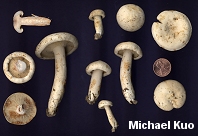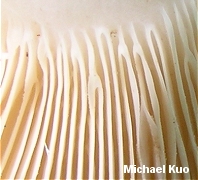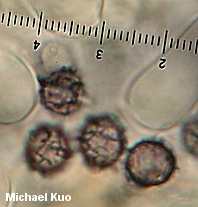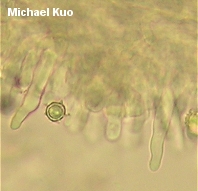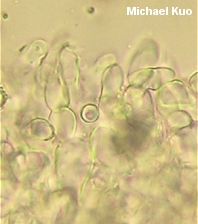| Major Groups > Gilled Mushrooms > Pale-Spored > Lactarius > Lactarius subvernalis var. cokeri |

|
Lactarius subvernalis var. cokeri [ Agaricomycetes > Russulales > Russulaceae > Lactarius . . . ] by Michael Kuo The pink staining, the whitish to buff-brown colors, the close or crowded gills, and the very acrid taste distinguish this attractive species. Lactarius piperatus is similar, but is typically a larger mushroom, and it does not stain pink when bruised or sliced. I have seen specimens of Lactarius subplinthogalus (which does stain pink) that were similarly colored, but that species has very distant gills and, often, a wavy or scalloped cap margin. Lactarius fumosus is also similar, but has a smoky brown cap and less acrid taste. Lactarius subvernalis var. cokeri is found in eastern North America under hardwoods. Hesler & Smith (1979) describe three varieties of Lactarius subvernalis, including var. cokeri (featured here), var. subvernalis (milk white but changing to yellow on exposure to air), and var. albo-ochraceus (milk white, drying red). Description: Ecology: Mycorrhizal with hardwoods--especially oaks; growing scattered or gregariously; summer and fall; widely distributed in eastern North America. Cap: 3-6 cm; convex at first, becoming flat, often with a central depression, or shallowly vase-shaped; the margin even by maturity; dry; finely suedelike; whitish to buff, or sometimes pale brownish with maturity; more or less evenly colored; sometimes bruising pink. Gills: Attached to the stem or running slightly down it; often forked near the stem; close or crowded; white at first, later dingy buff; often stained salmon pink by the milk when sliced. Stem: 5-7 cm long; 0.5-2 cm thick; more or less equal; dry; finely suedelike; without potholes; whitish; usually bruising pink; hollowing. Flesh: Soft; whitish but typically staining pink when cut (occasionally not staining, or staining only faintly and very slowly--especially in hot, dry weather). Milk: White; unchanging; usually staining surfaces pink; staining white paper slightly yellow. Odor and Taste: Odor not distinctive; taste usually strongly acrid, but occasionally slightly so or even mild. Chemical Reactions: KOH negative on cap surface. Spore Print: Pale yellow. Microscopic Features: Spores 6-8 µ; globose or subglobose; ornamentation 0.5-1.5 µ high, as amyloid spines and ridges forming a partial or complete reticulum. Pleuromacrocystidia absent. Cheilomacrocystidia abundant; up to 60 x 6 µ; subfusoid to subcylindric. Pileipellis a trichoepithelium or an epithelium. REFERENCES: (Smith & Hesler, 1962) Hesler & Smith, 1979. (Phillips, 1991/2005.) Herb. Kuo 07280306, 07140804. This site contains no information about the edibility or toxicity of mushrooms. |
© MushroomExpert.Com |
|
Cite this page as: Kuo, M. (2011, March). Lactarius subvernalis var. cokeri. Retrieved from the MushroomExpert.Com Web site: http://www.mushroomexpert.com/lactarius_subvernalis_cokeri.html |
